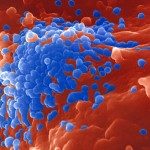Link to Pubmed [PMID] – 22491256
J. Immunol. 2012 May;188(10):5142-9
Chronic graft-versus-host disease (GVHD) follows allogeneic hematopoietic stem cell transplantation. It results from alloreactive processes induced by minor MHC incompatibilities triggered by activated APCs, such as plasmacytoid dendritic cells (pDCs), and leading to the activation of CD4 T cells. Therefore, we tested whether CD4(+) and pDCs, activated cells that produce high levels of reactive oxygen species, could be killed by arsenic trioxide (As(2)O(3)), a chemotherapeutic drug used in the treatment of acute promyelocytic leukemia. Indeed, As(2)O(3) exerts its cytotoxic effects by inducing a powerful oxidative stress that exceeds the lethal threshold. Sclerodermatous GVHD was induced in BALB/c mice by body irradiation, followed by B10.D2 bone marrow and spleen cell transplantation. Mice were simultaneously treated with daily i.p. injections of As(2)O(3). Transplanted mice displayed severe clinical symptoms, including diarrhea, alopecia, vasculitis, and fibrosis of the skin and visceral organs. The symptoms were dramatically abrogated in mice treated with As(2)O(3). These beneficial effects were mediated through the depletion of glutathione and the overproduction of H(2)O(2) that killed activated CD4(+) T cells and pDCs. The dramatic improvement provided by As(2)O(3) in the model of sclerodermatous GVHD that associates fibrosis with immune activation provides a rationale for the evaluation of As(2)O(3) in the management of patients affected by chronic GVHD.

